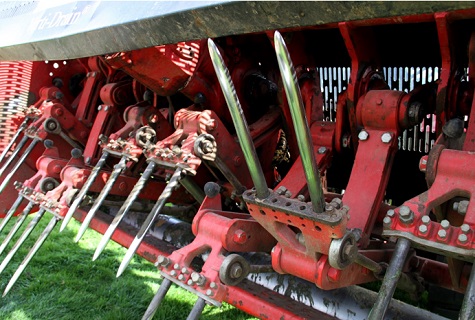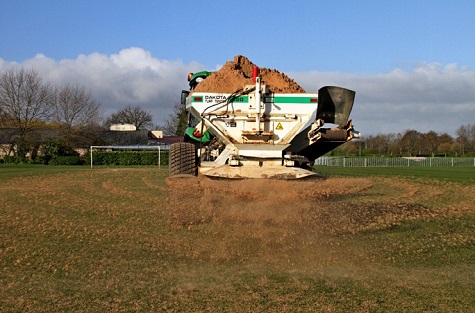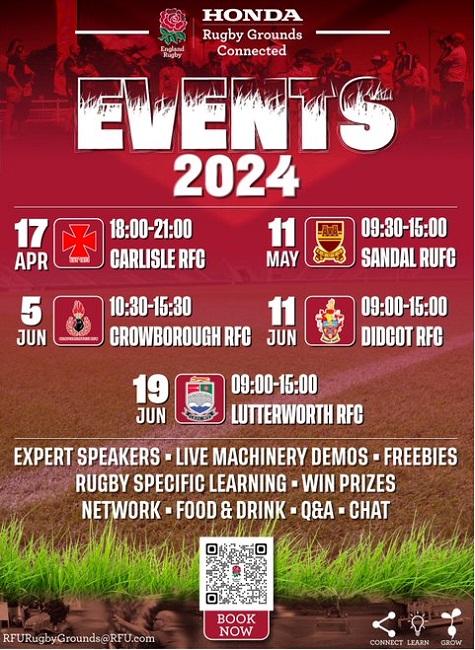We are now entering the last few weeks of the winter games season, with rugby and football clubs having to play their matches during the harshest weather period of the year – February to March - when poor conditions often result in saturated pitches that are prone to damage and wear.
Playing in these conditions can have serious consequences.
Firstly, we need to understand what problems are facing turf professionals when pitches become flooded and remain saturated for long periods of time. Once a pitch becomes saturated, that is to say, all the pore (air) spaces in the soil profile remain filled with water, then we are in a situation of the pitch being in a poor state and will be prone to damage.

Another saturated rugby pitch
However, the main contributing factor that reduces and damages pore spaces in soil is compaction, caused by compression forces, normally associated with play and use of machinery, particularly during wet weather periods. Over time, these compression forces reduce the pore spaces so that air, water and nutrient flow through the soil profile is restricted, and leads to many problems associated with compaction.
The heavier the soil, the longer it will take for the pitch to dry out; sandy soils are more free draining than heavy loam or clay soils and, therefore, will dry out more quickly.
Having an effective pitch drainage scheme will help. Most modern pitches tend to have primary and secondary drainage systems installed. These systems aid the removal of surface water quickly and tend to keep the pitches playable in periods of wet weather.

However, the effectiveness of any drainage system can be compromised over time when the drain runs become capped; it is important to retain a link between the drains and the playing surface.
This will be achieved by regular aeration work and the application of topdressings. Ideally, clubs should be putting on at least 40-60 tonnes of sand per pitch each year. This not only keeps the playing surface free draining, but also helps to restore levels.
Playing on saturated pitches will bring disastrous results. It is often better to postpone a fixture rather than ruin the playing surface for the rest of the season. Scrummage and lineout play are the main causes of damage on rugby pitches during wet weather periods. The severity of the damage will be dependent upon the soil type and the ability of the top 100mm to drain quickly.
It is important that, once the game has finished, remedial work is carried out to repair divots and stand the grass back up. Care should be taken not to further damage the pitch by trying to get machinery on when it is wet and saturated.
Brain Sandals of Turfcare Blog has recently produced an article How to Repair a Muddy Damaged Sports Pitch that gives good advice on dealing with a damaged playing surface.
However, the best way to continually improve your pitches is to invest in them over time, which generally means having a robust annal maintenance regime in place and carrying out appropriate end of season renovation works.
The success of these renovations will dictate the future performance of the pitches.

Any major resurfacing or drainage works are usually programmed to coincide with the planned end of season renovations. In most cases clubs are reliant on getting the work done by competent sports turf contractors, who have the correct equipment for these operations.
So, it is imperative you have secured or are seeking quotes for this work from well known, approved contractors.
The extent and nature of the works undertaken will be dependent on a number of factors:
- Type of pitch profile system, natural soil, rootzone, fibre re-inforced sand constructed pitch
- Level of wear
- Budgets available
- Time for completion and establishment
For most clubs a basic renovation of the playing surface ideally should consist of the following works, cleaning out the surface by verticutting / scarifying in two or three directions. Aerating the pitch (de-compacting) with a vertical punch or linear aerator. Top dressing with an approved sand/rootzone material usually applying anything between 50-100 tonnes of material. Then overseeding with a decent rye grass seed mixture at a rate between 30-50g/m2 depending on the condition of the pitch. Then finally fertilising with pre-seeding or spring/summer, applying at a rate of 25-35g/m2.

The cost of these operations will be dependent on a few factors; the number of pitches to be completed; types of materials used; scope of works; and haulage costs for material delivery of machinery and materials. Budget around £7,000 for a basic renovation based on industry contractors’ rates for a single pitch area (7000m2).
Due to the recent economic issues the country is facing, along with the war in Ukraine, we have seen a substantial rise in the costs of raw materials and fuel / transportation costs. We are now seeing in excess of £50 per tonne for top dressing and sand, depending on how much you are buying.
So, it is going to cost in the region of £4000 to buy 80 tonnes of material plus the cost of spreading. Seed prices have also risen to close on £90 per 20 kilo bag of seed. Twelve bags of seed to cover a full-size pitch will now cost in the region of £1000. On top of that you’ve got fertiliser costing around £25 -£30 per bag depending what NPK ration you choose - therefore it will now cost in the region of £300. Add into this the hiring of a contractor to undertake the aeration and scarifying and it will cost another £1000 per pitch.
That is a considerable investment for any club. However the benefits will be well worth the investment once you have successfully completed the works.
Also worth considering is a complete refurbishment of the pitch in terms of getting a contractor to come in and Koro off all the vegetation, cultivate, reform levels and reseed. This operation will cost more than an end of season renovation, but you are effectively giving yourself a brand new playing surface - and at around £12,000-£15000 it could be a good investment. However, timing and having the ability to water the pitch once completed, would need to be considered.

For me the most important issue is the ongoing maintenance work you undertake during the rest of the year. Why would you invest in a proper renovation and then refrain from implementing a decent maintenance regime at all other times?
It is generally the lack of appropriate maintenance that leads to the deterioration of the pitch in the first place.
It is important clubs keep themselves informed of any financial funding schemes that may be available for them to improve pitch facilities. The RFU and FA websites should be your first port of call, followed by Sport England. Also, keep an eye out for information being posted by your local authority websites, they may also have some funding initiatives going on.

As a Pitch Advisor for the RFU, there has never been a better time for clubs to improve their playing surfaces. Rugby Grounds Connected (RGC) is an easy access, two-way communication network between the RFU and rugby union grounds people. It is the main communication channel for the RFU to provide information and advice to grounds people and has special offers and exclusive benefits for members. Everything the RFU does with relation to pitch maintenance comes under the banner of Rugby Grounds Connected.
And finally, I’d just like to mention some renovation road shows tours that have been organised by the RFU and Campey Turf Care. The RFU have four dates (see poster above ) and the Campey Pitch Renovation Tour will visit 7 venues, beginning on the 11th April. I will see you all at Kidderminster Carolians on the 25th April.